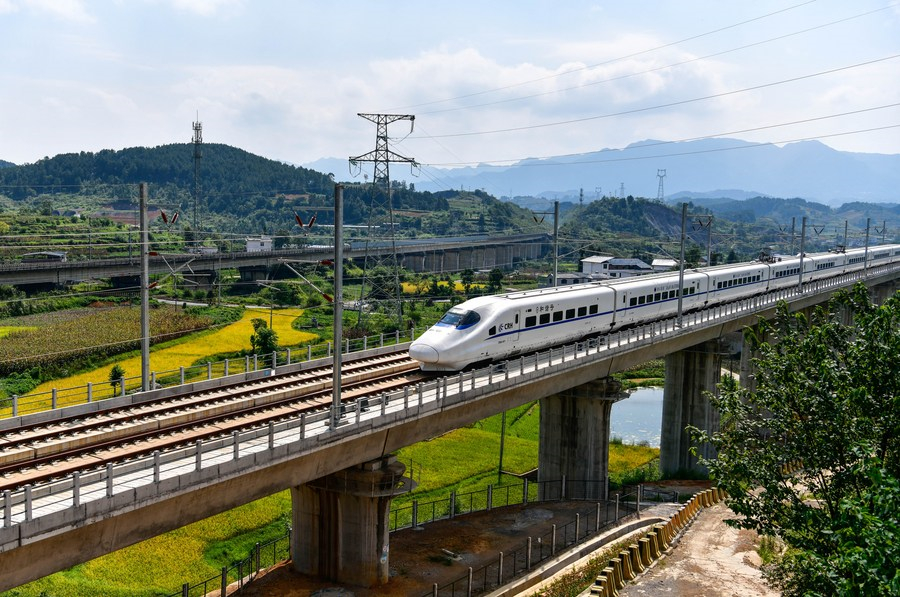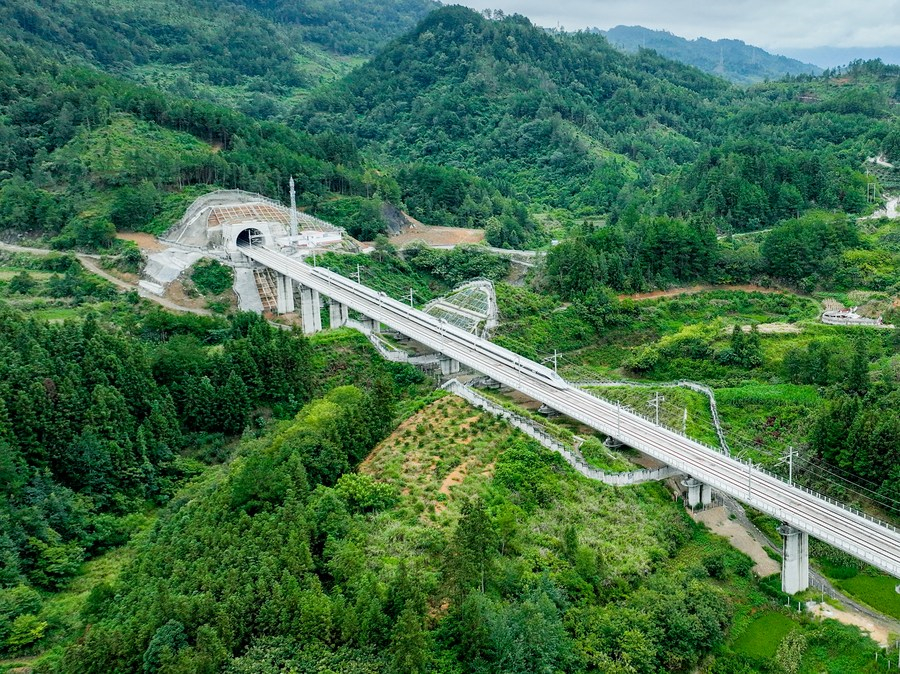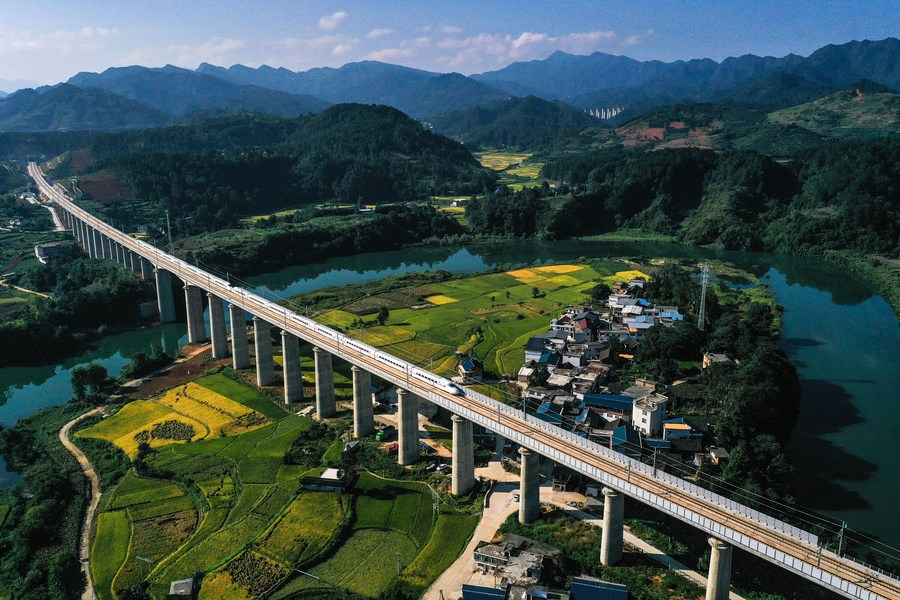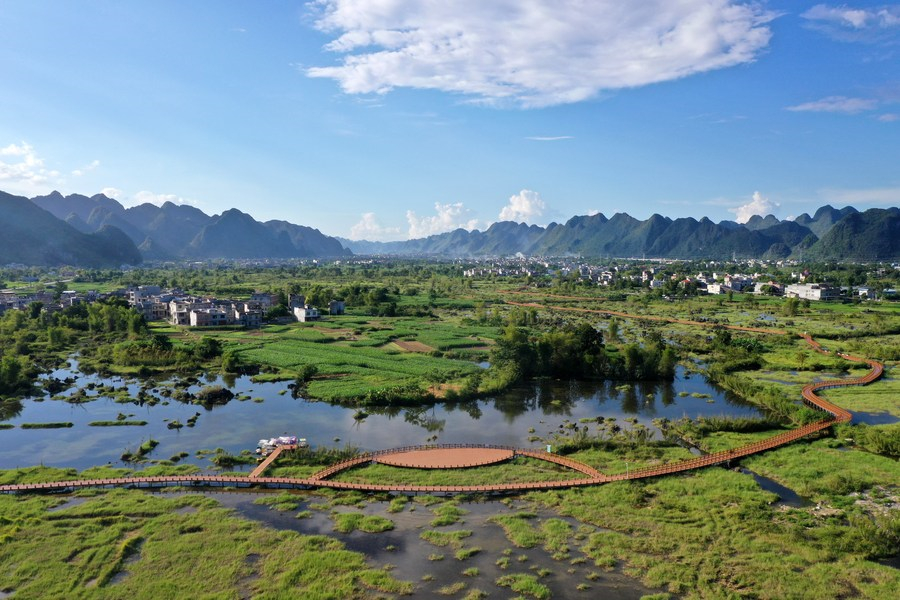High-speed rail network extends to south China's Karst regions
* Spanning 482 kilometers, the Guiyang-Nanning High-Speed Railway started operation on Thursday morning, marking the launch of full-scale high-speed rail services in south China's Karst regions.
* The railway is expected to have a positive impact on the local tourism industry and expedite the sluggish rural economy along the route.
* Ecological protection was the top priority during the construction of the project because the Yunnan-Guizhou Plateau slope the rail routes cross contains many rolling hills, rivers, and several scenic spots.
NANNING/GUIYANG -- A Fuxing bullet train on Thursday morning departed from Nanning, the capital of south China's Guangxi Zhuang Autonomous Region, marking the launch of full-scale high-speed rail services in south China's Karst regions.
Spanning 482 kilometers, the new railway connects Nanning with Guiyang, the capital of the southwestern province of Guizhou, according to China Railway Nanning Group Co., Ltd.
The Guiyang-Nanning High-Speed Railway was designed to facilitate a top speed of 350 kilometers per hour, and it is the first railway of its kind to be built in either Guizhou or Guangxi, both of which are known for their Karst landscapes.

This photo taken on Aug. 31, 2023, shows a bullet train running on the Guiyang-Nanning high-speed railway in Duyun City, southwest China's Guizhou Province. [Xinhua/Yang Wenbin]
The time it takes to travel from Guiyang to Nanning has now been reduced from over five hours to approximately three hours, greatly benefiting residents in mountainous areas and contributing to economic growth along the route.
The new railway has 13 stations, with the Guizhou section housing six of these stations and the Guangxi section housing seven stations.
GOLDEN CHANCE FOR MOUNTAINOUS AREAS
Running across two of the regions previously listed as experiencing extreme poverty due to stony desertification, the new line was designed to pass through over 30 ethnic enclaves in the mountainous areas of southwest China.
The railway is expected to have a positive impact on the local tourism industry and expedite the sluggish rural economy along the route, said He Qiaoliang, a senior engineer of China Railway Eryuan Engineering Group Co., Ltd.

This aerial photo taken on Aug. 23, 2023, shows a bullet train on confirming operation just exiting a 17-kilometer tunnel of the Guiyang-Nanning high-speed railway in southwest China's Guizhou Province. [Xinhua/Ou Dongqu]
Wu Mengyao in Huanjiang Maonan Autonomous County, Guangxi, said the new high-speed railway will be a boon for her hometown by bringing in more foot traffic.
"I'm also confident that our products, with their unique ethnic appeal, will resonate with our customers," said Wu, who runs a workshop producing cultural and creative products inspired by local intangible cultural heritage, including ethnic wear making, bamboo weaving, and clay sculpting.
Notable for its spectacular karst formations, Libo County, situated on the steep mountainside of Guizhou, has spectacular views in abundance, but it was also mired in poverty for a long time due to its geographical isolation.

A tourist takes photos at a scenic spot of Yaoshan Township in Libo County, southwest China's Guizhou Province, July 3, 2023. [Photo by Xiao Wei/Xinhua]
After the opening of the Guiyang-Libo section of the Guiyang-Nanning High-Speed Railway on August 8, the journey time between Guiyang and Libo was cut to less than an hour.
Ye Lin, the county Party secretary, said the railway will make Libo a huge draw for tourists throughout the year. The total number of visits to Libo in 2023 is predicted to surpass 25 million, according to a local tourism official.

This aerial photo taken on Aug. 15, 2023, shows tourists visiting the Xiaoqikong scenic spot in Libo County, southwest China's Guizhou Province. [Xinhua/Yang Ying]
BALANCING ECOSYSTEM PROTECTION AND TECHNICAL CHALLENGES
The construction of this railway was not an easy ride for those involved, as the building process had been dogged by many engineering challenges due to complex and often unfavorable geological conditions. It was estimated that over 90 percent of it would have to pass through tunnels or cross bridges.
Long Zongming, one of the chief designers of the Guizhou-Nanning High-speed Railway, told Xinhua that the difficulty lies in how to minimize the ecological impact while ensuring the stability and quality of the construction.

This aerial photo taken on Aug. 31, 2023, shows a bullet train running on the Guiyang-Nanning high-speed railway in Duyun City, southwest China's Guizhou Province. [Xinhua/Yang Wenbin]
Long said that ecological protection was the top priority of the project because the Yunnan-Guizhou Plateau slope the rail routes cross contains many rolling hills, rivers, and several scenic spots.
According to Long, the rail route took a 10-kilometer detour in the stretch from Guiding County Station to Duyun East Station, increasing the investment by about 1.4 billion yuan (about 192.18 million U.S. dollars), to protect the scenic spot located in between.

This aerial photo taken on Aug. 31, 2021, shows a view of the Chengjiang National Wetland Park in Du'an Yao Autonomous County, south China's Guangxi Zhuang Autonomous Region. [Xinhua/Lu Boan]
The 15.5-km-long Chengjiang Bridge in the Du'an Yao Autonomous County of Guangxi is the longest bridge along the railway, and 2.56 kilometers of this bridge pass through the Chengjiang National Wetland Park.
Su Li, a senior engineer at China Railway Beijing Engineering Group Co., Ltd., said that only 46 piers were set up in the park area, 34 fewer than the conventional scheme, to protect the wetland.
In addition, barriers 4 meters high and 3.69 kilometers long were set up along the rail routes to block the sound and light of high-speed trains to protect birds. Construction waste and waste water were also recycled after treatment to avoid polluting rivers and groundwater.
Video reporters: Liang Shun, Chen Luyuan, Tan Guanghua, Huang Kaiying, Yangchi, Liu Qinbing, Cui Xiaoqiang and Xie Wentao; video editors: Hong Ling, Hui Peipei, Zheng Xin, Hong Yan and Lin Lin.
























